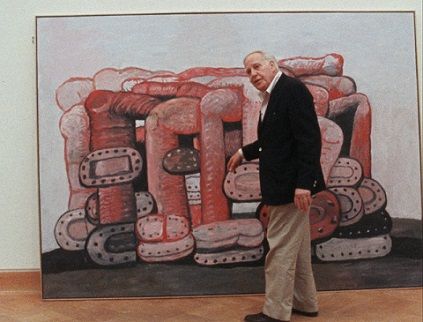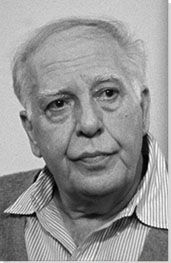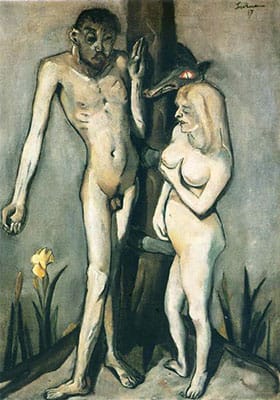Summary of Philip Guston
In a career of constant struggle and evolution, Philip Guston emerged first in the 1930s as a social realist painter of murals in the 1930s. Much later he also evolved a unique and highly influential style of cartoon realism. But he made his name as an Abstract Expressionist. He avoided the muscular gestures of painters such as Pollock and Kline, and opted for a lighter touch, painting shimmering abstractions in which forms seem to hover like mists in the foreground.
Accomplishments
- Guston's early career followed a pattern similar to that of many of his peers in Abstract Expressionism. He became interested in mural painting, and created fantastic scenes populated often by monumental, struggling figures. Although his early style was influenced in part by Italian Renaissance art, his backdrops invariably allude to contemporary cities and worldly conflicts.
- Guston was drawn towards Abstract Expressionism when he settled in New York in the late 1940s. There he evolved an abstract art characterized by warm clouds of red hatch-marks floating over formless white mists.
- The upheavals of 1960s made Guston increasingly uncomfortable with abstract painting, and his work eventually developed into the highly original cartoon-styled realism for which he is now best known. This took him back to his early years - to the style of the comics he loved as a boy, and to the imagery of hooded Klansmen that he first explored in the 1930s. Occasionally, Guston seems to identify with the Klansmen, but at other times his dark cartoons resemble fearful urban worlds of racism and violence.
Important Art by Philip Guston
Gladiators
Gladiators is an early example of Guston's social realist style, which he would maintain throughout his work as muralist with the WPA. It represents an attempt to capture something of the monumentality that he admired in Italian Renaissance art, though it is also one of the first pictures in which he explores the imagery of hooded figures, fists and shields, which would reappear in his late work.
Oil and pencil on canvas. 24 1/2 in. x 28 1/8 in. - Museum of Modern Art; gift of Edward R. Broida
Zone
Zone, a painting that reflects the focused concentration of Guston's mature work, suggests a warm calm, with its mist of red hatch-marks filling the painting's center. Here, Guston hones his mark-making, and builds layers of paint out of quick, small stokes that are quite distinct from the wilder gestures of some of his colleagues. "Look at any inspired painting," he once said, "it's like a gong sounding; it puts you in a state of reverberation."
Oil on canvas. 46 in.x48 in. - The Edward R. Broida Trust, Los Angeles
Last Piece
Last Piece is not Guston's last Abstract Expressionist painting, but it represents a transition away from the shimmering forms of the early 1950s towards the recognizable motifs of his later, more figurative works. If Buddhism, and concepts of nothingness, had informed his earlier abstractions, this represents a move away from those inspirations.
Goauche on board. 22 in.x30 in. - Museum of Modern Art; Estate of Philip Guston
The Studio
The Studio marks the beginning of Philip Guston's move away from abstraction and back to the figuration he practiced during the 1930s and 1940s, while he worked in the WPA mural painting style. This painting is widely recognized as an early meta-self portrait, in which Guston presents himself, laboring at his easel in the hood that he will continue to employ as a motif in future Klansmen works. Puffing on a cigar through his hood, the painter keeps his hand free to create his masterpiece: a cartoonish self-portrait of his hooded persona. Clement Greenberg once remarked that, with the exception of Arshile Gorky, Guston was the most romantic artist of his generation.
Oil on canvas. 48 in. x 62 in. - Musa Guston
City Limits
In City Limits, Guston's hooded characters squeeze into a car, like clowns, as if to go cause trouble in town. His Klansmen often undertook myriad tasks in his paintings, but more than most, this image reflects an aspect of Guston's original motivation for switching back towards realism: a growing fear at the spread of political disorder and upheaval in America.
Oil on canvas. 6.5' x 8'7 1/4". - Museum of Modern Art; Estate of Philip Guston
Head and Bottle
Head and Bottle exemplifies Guston's move away from painting the hooded Klansmen in the late 1960s. He invented this lima-bean shaped Cyclops head, with no body and one giant eye, to represent the all-seeing artist. In this work, the eye scrutinizes a green bottle, studying it as if about to pick up the nearby paintbrush to render it in red paint. The year after he painted this, Guston was hospitalized with exhaustion.
Oil on canvas. 48 in. x 62 in. - Musa Guston
Untitled
Towards the end of his life, Guston not only expanded his palette once again, to include blues and yellows, but he once again incorporated abstraction into many of his works.
Synthetic polymer paint on paper mounted on board. 20 in. x 30 in. - Museum of Modern Art - Estate of Philip Guston
Biography of Philip Guston
Childhood
Philip Guston was born Philip Goldstein, in Montreal, Canada, in 1913. He was the youngest of seven children born to a Jewish couple who had come to America after fleeing the pogroms in Russia. America seemed to offer shelter from persecution, yet the family found life difficult in their new country. Guston's father had been a saloon keeper, but he struggled to find work; in 1919 the family moved to Los Angeles with hopes of better fortunes, but they only encountered more hardship and also met with the racism that surrounded the growth of the Klu Klux Klan in the period. Around four years later, his father committed suicide by hanging and Guston discovered the body, an experience which profoundly marked him. As he moved into adolescence, Philip retreated in the fantasy world of comics, and started to become interested in drawing, which led his mother to enroll him in a correspondence course at the Cleveland School of Cartooning, thus beginning his training as an artist.
Early Training
In 1927, Guston attended Manual Arts High School in Los Angeles, where he met Jackson Pollock, and studied Cubism alongside the mystical philosophies of Krishnamurti and Ouspensky. After he and Pollock were expelled for distributing a leaflet mocking the English department, Guston was awarded a scholarship in 1930 to study at Otis Art Institute; in 1931 he had his first solo exhibition. Between his curtailed academic studies, and relocating to New York, he took odd jobs and traveled through Mexico to study anti-war murals. This inspired the painting of his own figurative murals, modeled after his favorite Renaissance masters and Mexican muralists, using thin layers of oil paint or fresco techniques. It was this enthusiasm that led to his enrollment in the Works Progress Administration's Federal Arts Project (WPA/FAP), and in the following years he would paint murals throughout the U.S.; in 1939 he completed a commission to paint an exterior wall of the WPA Building at the New York World's Fair.
Mature Period
During the winter of 1935 Pollock urged Guston to move to New York permanently, and introduced his friend to many of the New York School painters. Guston would continue to paint murals until 1942, but in the early 1940s he began a return to easel painting and evolved a more personal style influenced by elements of abstraction, realism, and references to myth. Over time the surfaces of his canvases became increasingly textured and he began developing his signature color palette, in which tones vary widely but hues are restricted. A major breakthrough came in 1950 with the completion of his first abstract works. Among them was Red Painting, in which the sharp separation between figure and ground vanishes, forms come in and out of focus and brushstrokes leave a palpable trace. A variety of unlikely influences were united in evolving this style: Chinese calligraphy, Mondrian's 'plus-minus' paintings of the 1910s, and Buddhism. Guston's interest in the latter was encouraged in part by his friendship with John Cage and Morton Feldman. His abstract style was certainly less grandly expressionistic than that of many of his peers, yet he still viewed the brushstroke as essentially autographic - a trace of the soul of the artist.
Late Period and Death

By the mid 1960s Guston was becoming uneasy with the meditative isolation that abstract painting encouraged, and political turmoil in the U.S. encouraged his return to figuration. Then in 1970, at the Marlborough Gallery in New York, he first exhibited pictures in the late style for which he is famous. These images are populated by enigmatic hooded figures, reminiscent of members of the Klu Klux Klan; they are not meant to directly reference racism but rather to take a stand against war, injustice, and the hypocrisy Guston witnessed in American politics. During the years before his death, in 1980, Guston continued to hone this imagery, creating increasingly enigmatic compositions reminiscent of still lifes or spare landscapes, with clusters of figures, heavy boots and tools, and cycloptic heads.
The Legacy of Philip Guston
Although the abstract painting which launched his career in the 1950s continues to be highly respected, Philip Guston remains best known for the figurative pictures he completed after 1970. These proved important in showing a way back to figurative painting after the long dominance of abstraction, as well as suggesting how painters inclined towards abstraction and gestural painting might address pop culture. In this respect Guston is unique among the Abstract Expressionists for the status accorded to his figurative work.
Influences and Connections

-
![Paolo Uccello]() Paolo Uccello
Paolo Uccello -
![Max Beckmann]() Max Beckmann
Max Beckmann -
![Giorgio de Chirico]() Giorgio de Chirico
Giorgio de Chirico ![Reuben Kadish]() Reuben Kadish
Reuben Kadish![Lorser Feitelson]() Lorser Feitelson
Lorser Feitelson
-
![Jackson Pollock]() Jackson Pollock
Jackson Pollock -
![Willem de Kooning]() Willem de Kooning
Willem de Kooning -
![Arshile Gorky]() Arshile Gorky
Arshile Gorky -
![John Cage]() John Cage
John Cage ![Morton Feldman]() Morton Feldman
Morton Feldman
-
![Abstract Expressionism]() Abstract Expressionism
Abstract Expressionism -
![Pop Art]() Pop Art
Pop Art ![New Image Painting]() New Image Painting
New Image Painting
Useful Resources on Philip Guston
- Night Studio: A Memoir Of Philip GustonOur PickBy Musa Mayer
- Guston in Time: Remembering Philip GustonBy Ross Feld

































